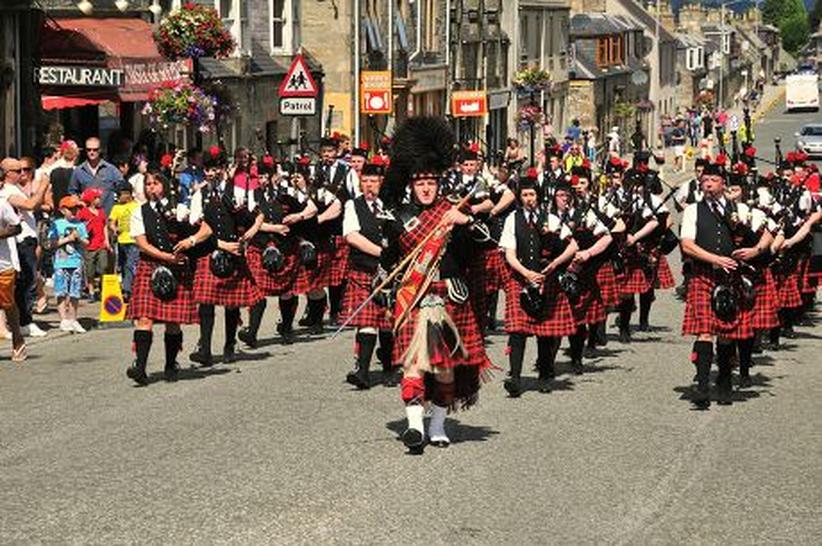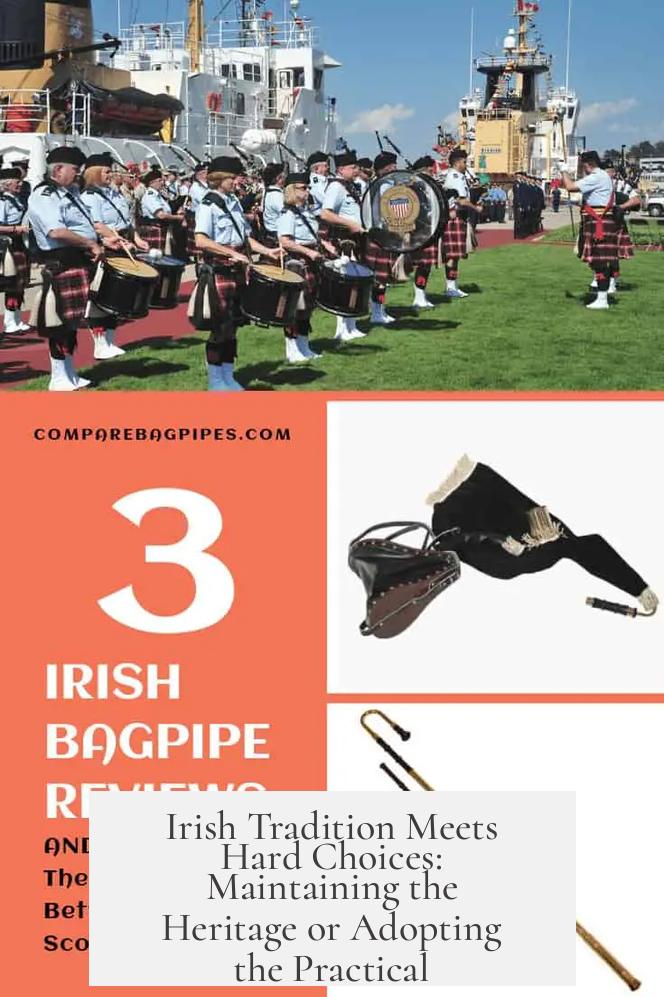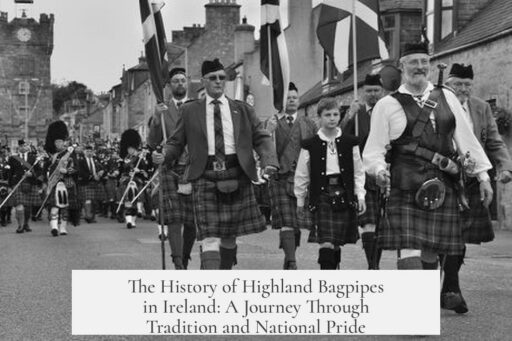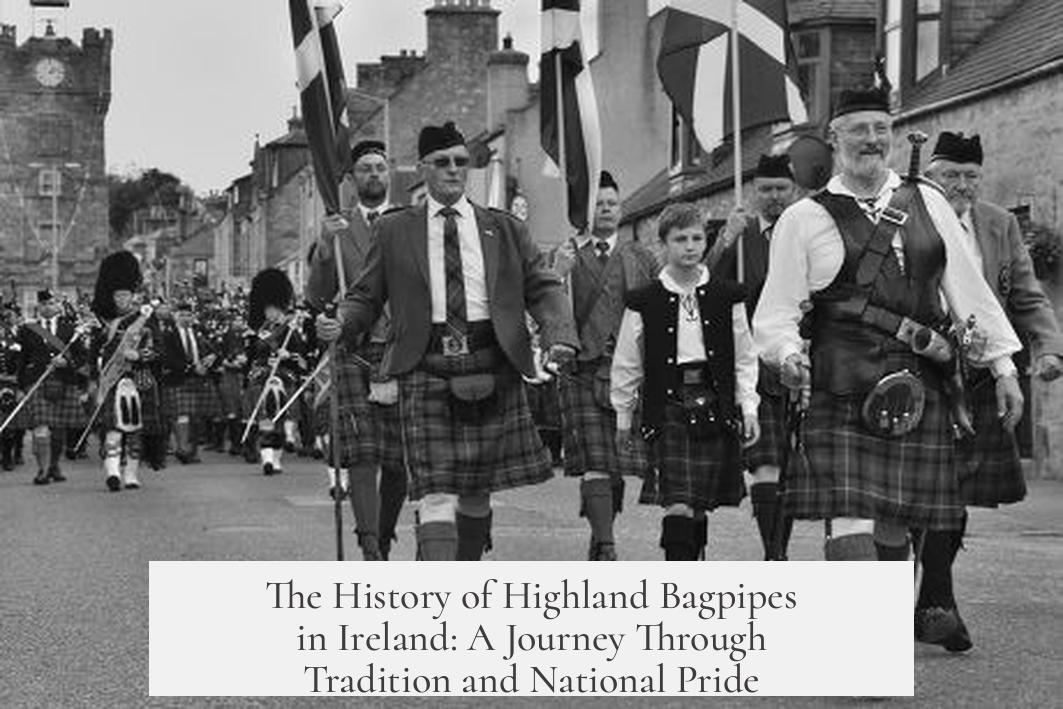The history of Highland bagpipes in Ireland reveals a complex interplay of indigenous tradition, industrial influence, and cultural adaptation. Ireland possessed mouth-blown bagpipes closely related to Scotland’s Great Highland Bagpipe. Despite this, Irish pipers often preferred the Scottish model due to manufacturing and tuning advantages. The unique Irish war pipes existed but did not achieve widespread adoption amid industrial challenges.
Bagpipe traditions in pre-modern Ireland and Britain suffer from poor documentation. Systematic records emerged only recently. Many piping practices remained folk-based and resistant to formal classification. This makes tracing the early development of Highland-style pipes in Ireland difficult.
Scotland’s Great Highland Bagpipe stands out as a highly uniform instrument. It features a conical chanter and three drones: one bass drone and two tenor drones, all tuned to an ‘A’ note. Uniform tonal design became essential in the late eighteenth century when pipes were played in military pipe bands. Standardized manufacturing allowed multiple pipers to perform in unison without clashing sounds. This industrial consistency helped spread the Highland pipe’s popularity beyond Scotland.
In Ireland during the nineteenth century, some musicians adopted the Irish war pipes. These resembled the Highland pipes but had only one tenor drone alongside the bass drone. This simpler drone setup distinguished the Irish variant. However, Irish war pipes lacked mass industrial production. The absence of a manufacturing base made it difficult to ensure consistent tuning between instruments. As a result, their use remained sporadic and localized.
Conversely, the Great Highland Bagpipe became easier to source and tune. Many Irish pipe bands defaulted to this model for its reliability and accessibility. For example, a San Francisco Irish pipe band in the 1980s uniquely featured Irish war pipes, but this remained an exception rather than a trend. The practicality of the Highland pipes outweighed efforts to sustain the native two-drone Ukrainian types.
While Highland pipes are mouth-blown, Irish piping also includes the uilleann pipes. These bellows-driven instruments represent a distinct and richly developed Irish tradition. Unlike the Highland pipes’ conical chanter, uilleann pipes use a cylindrical chanter. This design allows more uniform volume across notes and dynamic pitch control through pressure variations.
The uilleann pipes also possess metal keys, expanding their chromatic range. They create a very different sound and playing experience from Highland pipes. Bellows power the air supply, giving players the characteristic arm movement. This design contrasts with the Highland pipes’ blowstick and drone configuration. Uilleann pipes are highly associated with Irish traditional music and nationalist cultural identity, arguably stronger than Highland piping traditions in Ireland.
| Characteristic | Great Highland Bagpipe | Irish War Pipes | Uilleann Pipes |
|---|---|---|---|
| Air Supply | Mouth-blown (blowstick) | Mouth-blown (blowstick) | Bellows-blown (bellows on arm) |
| Number of Drones | Three (1 bass, 2 tenor) | Two (1 bass, 1 tenor) | None (uses regulators) |
| Chanter Type | Conical, 9 notes | Conical, similar to Highland but fewer drones | Cylindrical, chromatic with keys |
| Tuning Consistency | Standardized, industrially produced | Less standardized, difficult tuning | Pressure-dependent intonation, variable |
Mass production of Great Highland Bagpipes firmly cemented their role in Irish piping circles. Their industrial manufacture not only served Ireland but also attracted players worldwide—including Irish-American communities and regions as far as Pakistan and some Arabic countries. This widespread standardization helped Highland pipes overshadow some local Irish types.
Historical photographs support this coexistence and transitional phase. For instance, the Cork IRA Pipe Band of 1918 shows most pipers using the two-drone Irish war pipes. Yet some members play the Great Highland Bagpipe. It reflects a practical adoption of available instruments alongside efforts to maintain native tradition.
The nationalist revival movement in Ireland complicated interpretation of piping history. Cultural pride influenced perspectives on whether to preserve Irish war pipes or adopt the Highland pipes for modern expedience. This debate mixes historical fact with symbolic meaning, adding complexity to the narrative.
- Ireland had an established mouth-blown bagpipe tradition closely linked to Scotland’s Highland pipes.
- The Irish war pipes featured fewer drones but lacked mass industrial production, limiting wide use.
- Great Highland Bagpipes gained prominence in Ireland due to standardization and availability.
- Uilleann pipes remain a distinct Irish tradition, characterized by bellows-blown air supply and chromatic capability.
- Industrial manufacturing and tuning standardization determined the dominance of Highland pipes in Ireland and abroad.
The History of Highland Bagpipes in Ireland: An Intriguing Tale of Tradition, Practicality, and Pride

The history of Highland bagpipes in Ireland is a rich and layered story marked by indigenous pipes closely related to Scottish types, a unique local variety called the Irish war pipes, and the practical adoption of the Great Highland Bagpipe – the world-famous Scottish instrument that found its way into Irish ranks primarily due to industrial production and tuning simplicity. This narrative unfolds over centuries, blending cultural pride with real-world challenges in musical craftsmanship and performance. Let’s dive into this fascinating saga.
Ever wondered, “Did Irish pipers always play exactly like their Scottish cousins?” The answer reveals much about tradition, manufacturing, and nationalism.
Tracing Ancient Piping Traditions: Why Documentation Is Tricky
First off, capturing the exact history of bagpipes in Ireland isn’t as simple as flipping through dusty archives. Piping traditions in Ireland and Britain pre-modern times were barely documented. And those that were left resisted tidy classification. This means historians work with fragments, artifacts, and oral traditions. The result? A picture that’s more evocative than precise.
This ambiguity doesn’t diminish the fact that Irish mouth-blown bagpipes existed long before the Great Highland Bagpipe’s dominance. They belonged to Ireland’s heritage, reflecting a common Celtic evolution alongside Scotland. The catch is, that heritage comes with many unknowns.
The Great Highland Bagpipe: Why It Took Hold in Ireland
The Great Highland Bagpipe is known worldwide and has a very distinctive design: a conical chanter for melody and three drones – a bass and two tenors – tuned to play a continuous ‘A.’ This uniformity, standardized notably in the late 18th century, made it ideal for group performances, especially in military settings.
Why does this matter to Ireland? The Scottish pipes benefited from industrial-scale manufacturing. This ensured many players could obtain identical instruments, enabling harmonized band performances. In contrast, an Irish piper hunting for a compatible set often drew a blank. Production was limited, meaning tuning pipes to match was an uphill task.
This practicality drove many Irish pipers to embrace the Great Highland Bagpipe. The consistent quality, widespread availability, and ease of ensemble playing often outshone traditional Irish pipes that lacked such manufacturing support.
The Irish War Pipes: Local Flavor with Less Industry
Enter the Irish war pipes in the 19th century – a form with one tenor drone and one bass drone, unlike the Scottish tradition with two tenors. This design variation was notable but posed a big hurdle: it lacked industrial production and uniformity.
Because Irish war pipes were handcrafted and scattered in production, pipe bands had difficulties tuning their sets to play together. Practical demands favored the Scottish instrument instead. Decades later, seeing an Irish pipe band wielding Irish war pipes became a rare sight — such as the lone example spotted in 1980s San Francisco. That rarity highlights the uphill battle the Irish war pipes faced in gaining traction.
Irish Tradition Meets Hard Choices: Maintaining the Heritage or Adopting the Practical?

Here’s where cultural pride walks a tightrope with practicality. Irish pipers faced a real decision: should they cling to the indigenous two-drone Irish pipes and keep the tradition alive? Or should they adapt to the Scottish Great Highland Bagpipe’s superior availability and tuning ease?
Many chose expediency, leaning into the Scottish pipes for public performances, parades, and competitions. Others cherished the Irish war pipes but saw them as niche. This dynamic continues to reflect the balance between heritage preservation and the practical demands of performance.
Uilleann Pipes: The Proud, Distinctive Irish Piping Voice
While the Highland and Irish war pipes use mouth-blown air, Ireland’s other famous bagpipe, the uilleann pipes, take a different route. The word uilleann means ‘elbow’ in Irish, referring to the bellows inflated by the player’s arm.
This innovation distinguishes them from the Highland pipes, which rely on mouth-blown air. The uilleann pipes boast a cylindrical chanter, allowing all notes to sound at equal volume and even produce higher octaves by varying pressure. This complexity yields a softer, more nuanced sound and an extended chromatic scale through metal keys.
Uilleann pipes form a uniquely Irish tradition parallel to, but quite different from, the Highland bagpipes. They are less suited to group playing because their pitch can fluctuate, unlike the standardized Scottish pipes. If you’ve ever watched uilleann pipers, you might smile at their wing-flapping arm movements—bellows in action mark them apart.
Manufacturing’s Outsized Influence on Irish Bagpiping
The industrial production of Highland pipes gave them a global reach — from Ireland to Pakistani and Arabic tunes. In Ireland, it tilted the scales definitively. Irish war pipes could not compete against the efficiency and uniformity of mass-produced Highland pipes. This factor played a huge role in the bagpipes popular in Irish parades, military bands, and cultural revivals.
Even visual historical evidence points to this duality. Take the Cork IRA Pipe Band in 1918. Most players carried two-drone Irish war pipes, but a few wielded Great Highland pipes. This snapshot captures a moment when tradition and practicality intersected on the parade ground.
A Nationalist Revival Wrapped in Complexity and Pride
Much of the development in Irish bagpiping traditions is entangled with nationalist movements. The 20th-century revival sparked passionate debates about what defines authentic Irish music. Was the Scottish pipe an intrusion? Or was embracing it a savvy step forward?
These conversations often blend fact with pride and lore, complicating clear histories. But they show how music isn’t just sound—it’s identity, history, and politics all wrapped in melody and drone.
Summary: What to Take Away About Irish Highland Bagpipes
- The Irish had an indigenous mouth-blown bagpipe tradition closely aligned with Scotland’s.
- The Irish war pipes, featuring fewer drones, struggled against the industrial dominance of Highland pipes.
- Most Irish pipers turned to the Great Highland Bagpipe because it was easier to find and tune collectively.
- The uilleann pipes remain Ireland’s unique bagpiping jewel, bellows-driven and technically intricate.
- Industrial production ultimately shaped which pipes dominated Irish and global stages.
So, next time you hear bagpipes ringing through an Irish festival, consider the crossroads of tradition, practicality, and identity that this sound represents. It’s not just music; it’s a story of survival, adaptation, and pride over centuries of change.




